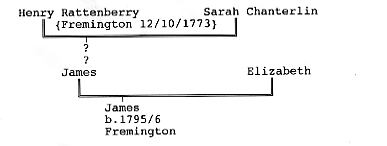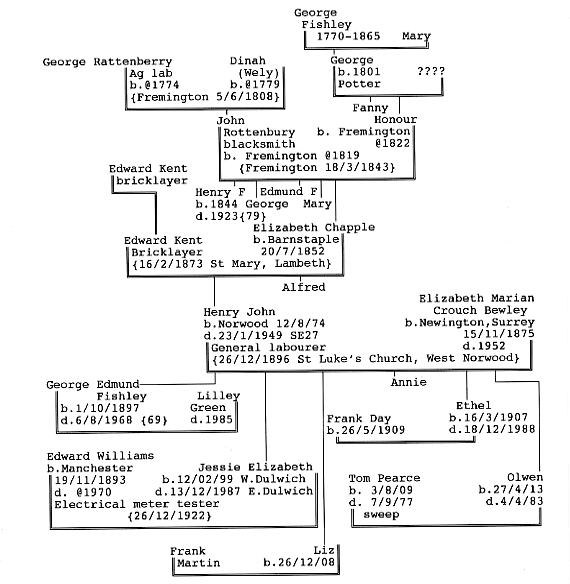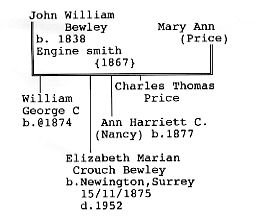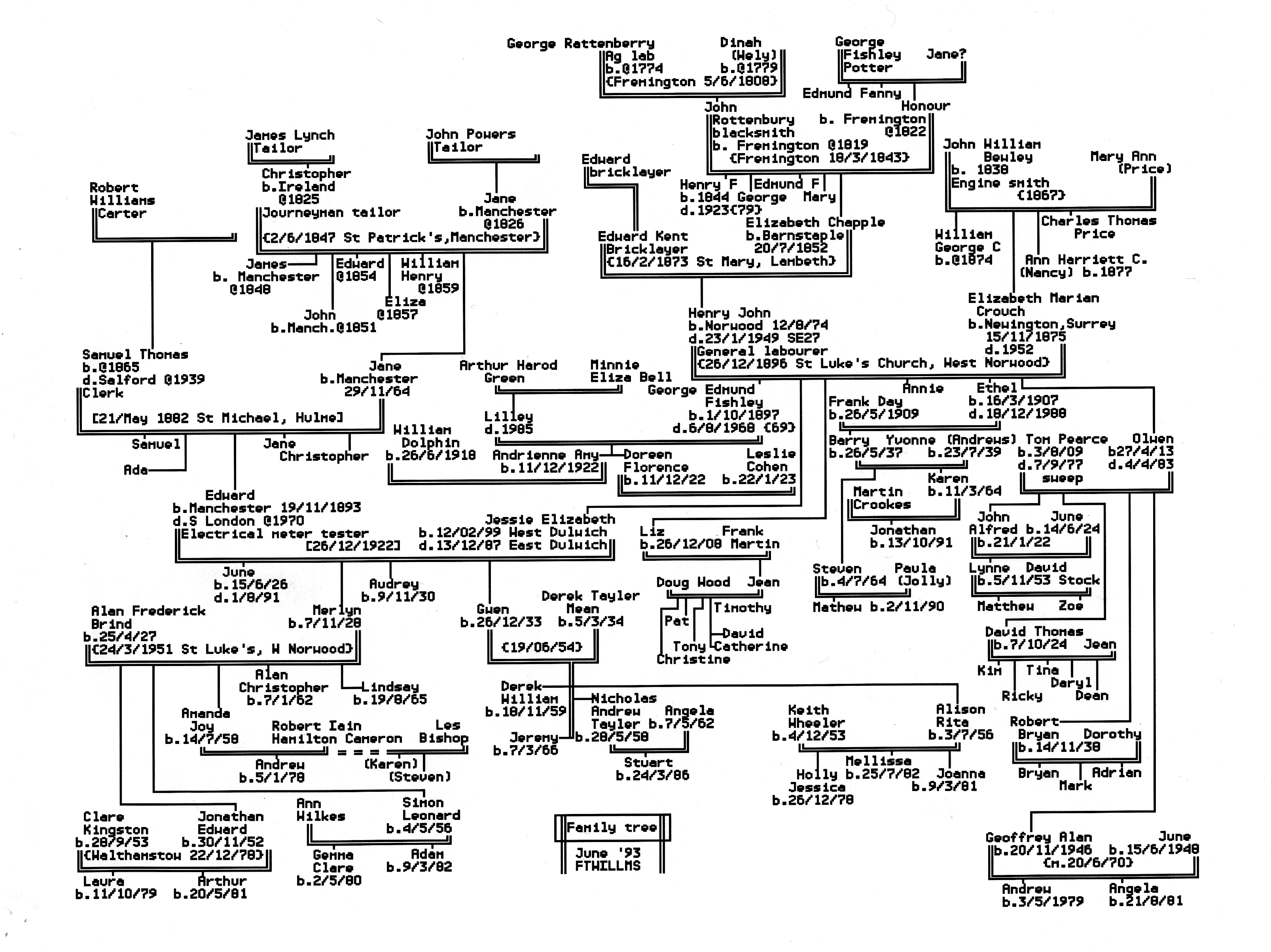
| The Rottenburys | The Kents | 50 years a potter | The Williams | The Brinds |
| See possible Brannam connection |
| John Rottenbury and Honour Fishley married on March 18, 1843. They were both at least 21, John may have been 24, Honour was probably a couple of years younger than him.
They married in their local parish church in their home town, Fremington, a short distance from Barnstaple. This was probably the same church in which John's parents, George Rattenberry and Dinah Wely had married, 35 years earlier. The two witnesses when John and Honour married were Edmund Fishley, probably Honour's brother or uncle, and Mary Rottenbury. Both John and Honour could write. He was a blacksmith, she a bonnet maker. |
|
| ||||||
|
|
| John Rottenbury | = Fremington March 18, 1843 | Honour (Fishley) |
| blacksmith | bonnet maker |

| In 1841, before Honour married she was living with her grandfather, a potter called George Fishley, who was aged about 70 when she was about 15. According to Honour's wedding certificate her father was also a potter called George.
Also at the same address as Honour and George when the 1841 census was taken was a Jane Fishley, aged about 60, and a Fanny Fishley, aged about 20. Fanny was probably Honour's sister, Jane may have been her grandfather's second wife? The Rottenburys and the Fishleys probably had very close ties. They lived almost next door to each other in a village which was, in any case, very small. By 1901 the population of Fremington was only 1,194. Not far from Fremington is the even smaller village of Milton Damerel (population 442 in 1901). In this tiny place there were at least two Rattenbury/Fishleigh marriages in the 50 years before John and Honour married. Alice Rattenbury & Francis Fishleigh in 1829 and John Rattenbury and Mary Fishleigh in 1795. Fremington was full of Rottenberrys, Fishleys and Chapples. Fishleys had been living in the village since at least 1614, Chapples since at least 1636 and Rottenberrys since at least 1739. My guess is that Honour's mother's maiden surname was Chapple. There was certainly a Fishley/Chapple marriage in Fremington: Elizabeth Fishley married Thomas Chapple on April 2, 1826. Early in 1993 the Museum of North Devon in Barnstaple, had an exhibition of pots made by Fremington Pottery. This pottery, it turned out, had been owned by the Fishleys. The display said:
" The Fishleys of Fremington. Members of the Fishley family worked at the Fishley pottery from the early 1800s until 1912. Their normal production was quite plain and utilitarian but it was traditional for a potter to undertake special work such as wedding pieces, pocket watch stands and harvest jugs for local farmers and some pieces were made for their own satisfaction
|
|
| George | Mary | Edmund | Robert | Eliza |
| b. 1801 | b. 1804 | 1806-1860 | 1808-1887 | b. 1810 |
| = Richard Cooper Fremington Oct 9, 1825 |
= Dorothy | = Jane Hill Fremington March 24, 1833 |
= Henry Buckingham Fremington March 23, 1834 |
| || |
| George | Mary | Edwin (Beer?) |
| b. 1838-9 | d. Feb 20 1912(79) | |
| = Martha d. April 23, 1876(47) |
| || |
| Isobel | ||
| = ?? Holland | ||
| || | ||
| William Fishley Holland b. 1889 |
After 1912 the Fremington pottery was sold to a Staffordshire potter, Ed Sadler, who after a few years sold it to Brannam's." The museum refers to "50 years a potter" by W Fishley Holland published by Pottery Quarterly in 1958. This book, written by a distant cousin, gives the flavour of life at the Fremington pottery nearly 100 years ago. For extracts from the book see appendix 1.
Fremington had its own quay and probably exported pottery all over the world. The patriarch George Fishley is almost certainly the George Fishley who was Honour's grandfather.
In Fremington Village & Pill, a self-guided trail, there is a copy of a painting of the old Fishley pottery (courtesy of the North Devon Atheneum Barnstaple photographed by the Museum of North Devon). It looks like a lean to attached to a giant bee hive.
The guide reveals: "Morris's Commercial Directory and Gazetteer of Devonshire of 1870 carried an advertisement for "Edwin B Fishley, manufacturer of all kinds of red earthen ware, seed pans, sea kale, rhubarb, garden and chimney pots'. Pipes, pitchers and ovens were also made, much being sent to Cornwall. The decorative ware was noted for its rich colours (examples can be seen in the Museum of North Devon in Barnstaple), and harvest jugs were a speciality. The clay is stone-free and needed to be kept clean before it was used for such items. Coarser wares required the addition of grit or gravel to the clay.
"Fuel costs were high, but the clay was relatively cheap. In 1900, six men and an apprentice worked here, most of the throwing being done by the master. The others each had specific tasks. Production at this pottery finally ceased about 1930."
There are several George Fishleys mentioned on the tombstones in the Fremington Parish Church Cemetery. The relevant inscriptions read:
|
"Sacred to the memory of Mary wife of George Fishley of this parish who departed this life the 21st day of April in the year of our Lord 1859. Aged 61 years." |
|
"Sacred to the memory of George Fishley of this parish who departed this life January the 22, 1838 aged 57 years. Be merciful unto me oh God for my soul most trusteth in thee therefore under the shadow of thee thy wings shall be my refuge..... Also to the memory of George the son of Edmund and Dorothy Fishley of this parish who departed this life March the 26th 1839 aged 5 months." |
| Edmund was probably Honour's uncle. In 1841 he lived at Muddlebridge, Fremington, was aged about 30 and like his father was a potter. His wife was Dorothy and his children were Mary, 11, and Edwin, 9.
John and Honour lived a few houses away from each other at Bickington in 1841, when the census was taken. John was still a blacksmith's apprentice, Honour was working as a bonnet maker. |

|
Just down the road and still in Bickington in 1841 was a Henry Rottenberry, a journeyman mason in his mid 20s. He may well have been John's brother. John certainly called his first son Henry, suggesting a common Henry Rottenberry ancestor. Henry was married to Fanny, though not Fanny Fishley, she was still living with her parents. Henry's wife was a lace maker. It seems extraordinary that the wife of a journeyman mason should need to work. Henry and Fanny had two children, Eliza (7) and Henry (3).
Also in Bickington in 1841, lived George Rottenberry, in his mid 40s and also a mason, with his wife Rebecca and daughters Susan, 15, Joseph, 14, and Jane, 10. George and Rebecca are buried in the Fremington church yard. Their headstone says: "Sacred to the memory of George Rottenberry of this parish who departed this life June the 8th 1851 aged 56 years And in my prosperity I said I shall never be removed. Psalms XXX 6 V. Also to the memory of Rebecca wife of the above George Rottenberry who departed this life January the 7th 1864 aged 76 years also to the memory of George Daniel the son of George Rottenberry and Elizabeth his wife of Barnstaple Draper who departed of this life January 5th 1853 aged 8 months." In North Lane, Fremington, lived William Rottenbery, also in his 20s and another mason, his wife Mary and son William (2), in 1841. Robert Fishley, a potter's labourer, and his wife Jane, lived at West Combrew, Fremington. Their household in 1841 included a six year old girl called Mary Rottenberry. How Mary fits into the picture is impossible to say. Perhaps she was an orphan though why she was living with the Fishleys is a mystery. One of the clues which suggests a Chappell connection is that a second Mary Rottenberry, aged 15, was a servant in the household of William and Elizabeth Chappell in 1841. He was in his mid 70s, she perhaps 15 years younger. He was independent, or in other words a pensioner. A William Chappell married an Elizabeth Crocker on the 28th August 1817, in Fremington. In Brookfield, Fremington, in 1841 lived Mary Chappell, aged about 90, and described as independent. She seems to have been a part of the household of a clay merchant called Stephen Crocker. Mary might have been the wife of Samuel Chappell and the mother of John, Mary Elizabeth and Samuel, all Christened in the 1780s. |
|
The biggest clue that the Chappell family are relatives is that John and Honour named their daughter Elizabeth Chapple. Chapple is such an unusual forename that it seems clear they were giving her Honour's family name.
Elizabeth Chapple Rottenbury was born in 1852 in Maiden Street, Barnstaple, where John and Honour had moved. This was probably a road close to Barnstaple Bridge. Three arches of the bridge (the ones closest to the town) are called the Maiden Arches. In early 1993 I walked down Maiden Lane, a small alleyway with an open drain running down the middle of the road. There must be about a dozen restaurants in it. Few if any of the houses show any sign of being more than a century old. In 1851, when the census was taken, John & Honour were living in Maiden Street with their children Henry, 7, George, 5, Edmund, 3, and Mary, 1. John was a blacksmith, Honour's occupation was blank. Perhaps she had given up bonnet making? John and Honour moved to Barnstaple soon after marrying and all the children were born there. See this link for the Brannam connection. The family next moved to the London area, perhaps John was seeking work. John probably died in 1856, in Greenwich. In the first quarter of 1859 Honour married again in Lewisham. At present I do not know the name of her husband. On the 16th of February, 1873, Elizabeth Chapple Rottenbury married a bricklayer called Edward Kent, himself the son of a bricklayer called Edward Kent. They married at St Mary, Lambeth. Edward Kent signed his name, Elizabeth made her mark. The Rottenbury family probably couldn't afford to pay for the education of a girl. Elizabeth's brothers had already married. Henry Fishley Rottenbury married in the last quarter of 1865 in Lambeth, perhaps the same church as Elizabeth married in? Edmund Fishley Rottenbury married in Camberwell in the first quarter of 1872. In the last quarter of 1891 a death certificate for a one year old girl named Jessie Annie Rottenbury was issued in Greenwich. It seems likely she was the child of Henry Fishley or Edmund Fishley Rottenbury, since Jessie and Annie are both family names. The third brother, George F (presumably Fishley), may not have married. He appears to have died in Lambeth in the first quarter of 1897 at the age of 51. Henry F died in the second quarter of 1923 (aged 79) and Edmund F died in the last quarter of 1925 in Reigate aged 77. Not much is known about the Rottenberrys after that time. Except Andrienne Dolphin, daughter of George Edmund Fishley Kent, said her father had joined the Coulsdon Freemason's Lodge because his cousin Edwin Rottenberry had been a member. Edwin, she recalls, lived near Emmanuel Church, Clive Road, Norwood. But there were two Rottenburys in the London telephone directory in 1993. |
| Andrienne's father was always called Fish by her brother in law Leslie Cohen. When they went to Spain the nickname changed to Piscardo. But she did not know about the history of the Fishley family. |

See 50 Years A Potter by W Fishley Holland, a Fishley descendant who worked in the Fremington pottery in the early years of the 20th century.
| The Rottenburys | The Kents | 50 years a potter | The Williams |
